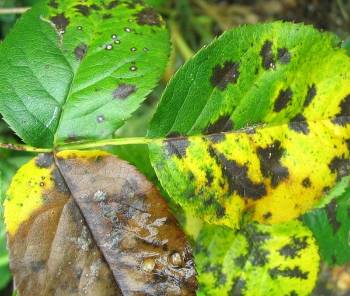Black Spots on Roses
Nashville, Ark. – Have you noticed black spots on your roses? Black spot is caused by a fungus (Diplocarpon rosae) and is the most important disease of roses in Arkansas. Each year, rose growers need to take steps to battle this serious disease that affects most rose varieties. Hybrid tea roses are the hardest hit although the fungus may infect all types. The optimum weather conditions for disease development are 75° - 85°F with high relative humidity or rainy periods. When leaves remain wet for six or more hours, the fungus infects them. Canes can also be infected. Black spot is less of a problem under greenhouse conditions since relative humidity and temperature can be controlled.
Leaf spots are the most characteristic symptoms. The black spots are round with feathered edges and are up to 1/2 inch across. Spots are mostly on the upper surface of the leaf and often have a yellow halo around them. When many spots are present on the leaves, they cause the leaves to turn yellow and fall off. Lower leaves usually become infected first. Excessive leaf drop from this disease weakens the plant, resulting in other problems. New spots can appear in as little as five days when conditions are favorable for infection. Cane symptoms of black spot are less obvious. Small, purple blister-like blotches appear on the canes. These blotches become black with age. Cane infections are very important in the survival of the fungus during the winter and are sources of infection in the spring as temperatures warm and rainfall increases. Periods of rainfall or any other source of overhead water that wets the leaves can lead to a flareup of black spot. During wet periods, the fungus produces thousands of microscopic spores on infected leaves and canes, which can be carried to fresh leaves by wind or splashing water. Since the fungus can withstand a wide range of temperatures, infections may continue throughout the season as long as moisture is present on the plant.
Dying or dead canes and fallen leaves should be removed and disposed of before new growth begins in the spring. If feasible, spotted leaves remaining on the plant should also be removed since these can also be a source of infection. Overhead irrigation that prolongs leaf wetness should be avoided if possible, since moisture is a significant factor for infection. If plants are irrigated overhead, watering should be done in the early morning hours to minimize leaf wetness periods. Use of drip tubes or soaker hoses is preferred. Always select a sunny location, well drained soils and areas where there is good air movement to minimize leaf wetness.
Planting resistant varieties is the most effective way to prevent black spot. Some of these varieties may develop a low level of black spot but will require less maintenance than those that are susceptible. The degree of susceptibility may depend somewhat on local environmental conditions. Since the fungus can survive and continue to produce spores on fallen leaves and dying canes, good sanitation is an integral part of an effective control. For those growers who have to deal with the disease on a regular basis, fungicide applications will be required in combination with good sanitation. Homeowner fungicides labeled for black spot include Spectracide Immunox, Fertilome Liquid Systemic Fungicide, Ortho Funginex and Greenlight FungAway. For specific information, consult Extension publication MP154, Arkansas Plant Disease Control Products Guide, or contact the Howard County Extension office at 870-845-7517.
For more information, you can visit www.uaex.uada.edu, or send an email to skroll@uada.edu. Howard County Extension office is still working and is there for all the residences in Howard County during this time.
By Samantha Kroll
County Extension Agent - Agriculture
The Cooperative Extension Service
U of A System Division of Agriculture
Media Contact: Samantha Kroll
County Extension Agent - Agriculture
U of A Division of Agriculture
Cooperative Extension Service
421 N. Main Nashville AR 71852
(870) 845-7517
skroll@uada.edu
Related Links
The Arkansas Cooperative Extension Service is an equal opportunity institution. If
you require a reasonable accommodation to participate or need materials in another
format, please contact your County Extension office (or other appropriate office)
as soon as possible. Dial 711 for Arkansas Relay.
Pursuant to 7 CFR § 15.3, the University of Arkansas System Division of Agriculture
offers all its Extension and Research programs and services (including employment)
without regard to race, color, sex, national origin, religion, age, disability, marital
or veteran status, genetic information, sexual preference, pregnancy or any other
legally protected status, and is an equal opportunity institution.
